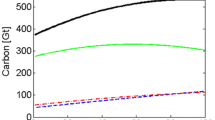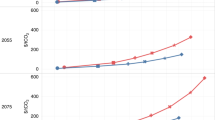Abstract
Forests can mitigate greenhouse gases by storing carbon (SEQU) and supplying woody biomass for burning in power plants with CCS (WBCCS). The paper uses GTM to understand the global dynamics of forests and WITCH to determine the most cost-effective mitigation methods to limit long-term radiative forcing. The analysis finds that both SEQU and WBCCS are effective but the most effective choice is to use them together. WBCCS + SEQU accounts for 23–28% of all mitigation. SEQU initially dominates while carbon prices are low while WBCCS becomes more important later with especially high carbon prices. Forest mitigation encourages land use to shift towards forests, increasing natural forests and especially managed forests. SEQU leads to larger trees and more natural forestland and WBCCS leads to faster growing trees and more managed stands.





Similar content being viewed by others
References
Andersson K, Richards KR (2001) Implementing an international carbon sequestration program: can the leaky sink be fixed? Clim Pol 1:73–88
Andersson K, Evans TP, Richards KR (2009) National forest carbon inventories: policy needs and assessment capacity. Clim Chang 93:69–101
Azar C, Lindgren K, Obersteiner M, Riahi K, van Vuuren D, den Elzen K, Möllersten K, Larson ED (2010) The feasibility of low CO2 concentration targets and the role of bio-energy with carbon capture and storage (BECCS). Clim Chang 100(1):195–202
Bosetti V, Carraro C, Galeotti M, Massetti E, Tavoni M (2006) A world induced technical change hybrid model. The energy journal, special issue. Hybrid modeling of energy-environment policies: reconciling bottom-up and top-down, 13–38
Bosetti V, Carraro C, Galeotti, Massetti E, Tavoni M (2007) The WITCH model: Structure, Baseline and Solution. FEEM Working Paper N. 10.2007, Milan
Bosetti V, De Cian E, Sgobbi A, Tavoni M (2009) The 2008 Witch model: new model features and baseline. FEEM Work Article 2009:085
Calvin K, Wise M, Kyle P, Patel P, Clarke L, Edmonds J (2014) Trade-offs of different land and bioenergy policies on the path to achieving climate targets. Clim Chang 123(3–4):691–704
Carraro C, Favero A, Massetti E (2012) Investments and public finance in a green, low carbon economy. Energy Econ 34(Supplement 1):S15–S28
Chum H, Faaij A, Moreira J, Berndes G, Dhamija P, Dong H, Pingoud K (2011) Bio-energy. In: Edenhofer O, Pichs-Madruga R, Sokona Y, Seyboth K, Matschoss P, Kadner S, Zwickel T, Eickemeier P, Hansen G, Schlomer S, Von Stechow C (eds) IPCC Special Report on Renewable Energy Sources and Climate Change Mitigation. Cambridge University Press, Cambridge, United Kingdom and New York, pp. 209–332
Clarke L, Jiang K, Akimoto K, Babiker M, Blanford G, Fisher-Vanden K, Hourcade J-C, Krey V, Kriegler E, Löschel A, McCollum D, Paltsev S, Rose S, Shukla PR, Tavoni M, van der Zwaan BCC, van Vuuren DP (2014) Assessing transformation pathways. In: Edenhofer O, Pichs-Madruga R, Sokona Y, Farahani E, Kadner S, Seyboth K, Adler A, Baum I, Brunner S, Eickemeier P, Kriemann B, Savolainen J, Schlömer S, von Stechow C, Zwickel T, Minx JC (eds) Climate Change 2014: Mitigation of Climate Change. Contribution of Working Group III to the Fifth Assessment Report of the Intergovernmental Panel on Climate Change. Cambridge University Press, Cambridge, United Kingdom and New York
Creutzig F, Ravindranath NH, Berndes G, Bolwig S, Bright R, Cherubini F, Chum H, Corbera E, Delucchi M, Faaij A, Fargione J (2015) Bioenergy and climate change mitigation: an assessment. GCB Bioenergy 7(5):916–944
Delucchi M (2010) Impacts of biofuels on climate change, water use, and land use. Ann N Y Acad Sci 1195:28–45
Edmonds J, Luckow P, Calvin K, Wise M, Dooley J, Kyle P, Kim SH, Patel P, Clarke L (2013) Can radiative forcing be limited to 2.6 Wm-2 without negative emissions from bioenergy and CO2 capture and storage? Clim Chang 118(1):29–43
Favero A, Massetti E (2014) Trade of woody biomass for electricity generation under climate mitigation policy. Resour Energy Econ 36(1):166–190
Favero A, Mendelsohn R (2014) Using markets for woody biomass energy to sequester carbon in forests. J Assoc Environ Resour Econ 1-2:75–95
Favero A, Mendelsohn R (2017) The land-use consequences of woody biomass with more stringent climate mitigation scenarios. J Environ Prot 8(01):61
FAO (Food and Agriculture Organization of the United Nations) (2012) State of the World’s Forest Report. Food and Agriculture Organization, Rome
Haxeltine A, Prentice IC (1996) BIOME3: an equilibrium terrestrial biosphere model based on ecophysiological constraints, resource availability, and competition among plant functional types. Glob Biogeochem Cycles 10(4):693–709
Hertel T, Golub A, Jones A, O’Hare M, Plevin R, Kammen D (2010) Global land use and greenhouse gas emissions impacts of US maize ethanol: estimating marketmediated responses. Bioscience 60:223–231
Houghton RA, Byers B, Nassikas AA (2015) A role for tropical forests in stabilizing atmospheric CO2. Nat Clim Chang 5(12):1022–1023
Humpenöder F, Popp A, Dietrich JP, Klein D, Lotze-Campen H, Bonsch M, Bodirsky BL, Weindl I, Stevanovic M, Müller C (2014) Investigating afforestation and bioenergy CCS as climate change mitigation strategies. Environ Res Lett 9(6):064029
Jones AD, Calvin KV, Collins WD, Edmonds J (2015) Accounting for radiative forcing from albedo change in future global land-use scenarios. Clim Chang 131(4):691–703
Kreidenweis U, Humpenöder F, Stevanović M, Bodirsky BL, Kriegler E, Lotze-Campen H, Popp A (2016) Afforestation to mitigate climate change: impacts on food prices under consideration of albedo effects. Environ Res Lett 11(8):085001
Mason CF, Plantinga AJ (2013) The additionality problem with offsets: optimal contracts for carbon sequestration in forests. J Environ Econ Manag 66:1–14
Mendelsohn R, Sedjo R, Sohngen B (2012) Forest carbon sequestration. In: Parry I, de Mooij R, Keen M (eds) Fiscal policy to mitigate climate change: a guide for policymakers. International Monetary Fund, Washington, DC
Mendelsohn R, Prentice I, Schmitz O, Stocker B, Buchkowski R, Dawson B (2016) The ecosystem impacts of severe warming. Am Econ Rev Proc 106(5):612–614
Moulton RJ, Richards KR (1990) Costs of sequestering carbon through tree planting and forest management in the United States. General Technical Report WO (USA)
Plantinga AJ, Mauldin T, Miller DJ (1999) An econometric analysis of the costs of sequestering carbon in forests. Am J Agric Econ 81(4):812–824
Richards KR, Stokes C (2004) A review of forest carbon sequestration cost studies: a dozen years of research. Clim Chang 63(1–2):148
Rogelj J, Luderer G, Pietzcker RC, Kriegler E, Schaeffer M, Krey V, Riahi K (2015) Energy system transformations for limiting end-of-century warming to below 1.5 C. Nat Clim Chang 5(6):519–527
Searchinger TD, Hamburg SP, Melillo J, Chameides W, Havlik P, Kammen DM, Likens GE, Lubowski RN, Obersteiner M, Oppenheimer M, Robertson GP, Schlesinger WH, Tilman GD (2009) Fixing a critical climate accounting error. Science 326(5952):527–528
Sedjo R, Tian X (2012) Does wood bioenergy increase carbon stocks in forests? J For 110(6):304–311
Sedjo RA, Sohngen B, Riddle A (2015) Land use change, carbon, and bioenergy reconsidered. Clim Chang Econ 6.01(2015):1550002
Smith P, Bustamante M, Ahammad H, Clark H, Dong H, Elsiddig EA, Haberl H, Harper R, House J, Jafari M, Masera O, Mbow C, Ravindranath NH, Rice CW, Robledo Abad C, Romanovskaya A, Sperling F, Tubiello F (2014) Agriculture, Forestry and Other Land Use (AFOLU). In: Edenhofer O, Pichs-Madruga R, Sokona Y, Farahani E, Kadner S, Seyboth K, Adler A, Baum I, Brunner S, Eickemeier P, Kriemann B, Savolainen J, Schlömer S, von Stechow C, Zwickel T, Minx JC (eds) Climate Change 2014: Mitigation of Climate Change. Contribution of Working Group III to the Fifth Assessment Report of the Intergovernmental Panel on Climate Change. Cambridge University Press, Cambridge, United Kingdom and New York
Smith P, Davis SJ, Creutzig F, Fuss S, Minx J, Gabrielle B, Kato E, Jackson RB, Cowie A, Kriegler E, Van Vuuren DP (2016) Biophysical and economic limits to negative CO2 emissions. Nat Clim Chang 6(1):42–50
Sohngen B, Mendelsohn R (2003) An optimal control model of Forest carbon sequestration. Am J Agric Econ 85(2):448–457
Sohngen B, Mendelsohn R, Sedjo R (1999) Forest management, conservation, and global timber markets. Am J Agric Econ 81(1):1–13
Stavins RN (1999) The costs of carbon sequestration: a revealed-preference approach. Am Econ Rev 89(4):994–1009
Tavoni M, Sohngen B, Bosetti V (2007) Forestry and the carbon market response to stabilize climate. Energy Policy 35(11):5346–5353
van Kooten GC, Binkley CS, Delcourt G (1995) Effect of carbon taxes and subsidies on optimal Forest rotation age and supply of carbon services. Am J Agric Econ 77(2):365–374
Wise M, Calvin K, Thomson A, Clarke L, Bond-Lamberty B, Sands R, Smith SJ, Janetos A, Edmonds J (2009) Implications of limiting CO2 concentrations for land use and energy. Science 324(5931):1183–1186
Wise M, Hodson EL, Mignone BK, Clarke L, Waldhoff S, Luckow P (2015) An approach to computing marginal land use change carbon intensities for bioenergy in policy applications. Energy Econ 50:337–347
Author information
Authors and Affiliations
Corresponding author
Electronic supplementary material
ESM 1
(DOCX 331 kb)
Rights and permissions
About this article
Cite this article
Favero, A., Mendelsohn, R. & Sohngen, B. Using forests for climate mitigation: sequester carbon or produce woody biomass?. Climatic Change 144, 195–206 (2017). https://doi.org/10.1007/s10584-017-2034-9
Received:
Accepted:
Published:
Issue Date:
DOI: https://doi.org/10.1007/s10584-017-2034-9




